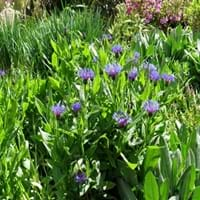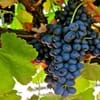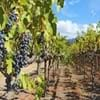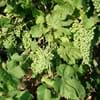Life Span
Perennial
Annual and Perennial
Type
Fruit
Flowering Plants, Shrubs
Origin
Hybrid origin
World/Pandemic, North America, Europe, Russia/Siberia, China, Korea
Types
PRIMOCANE RED RASPBERRIES ,FLORICANE RED RASPBERRIES
Bigleaf hydrangea, Hortensia, Smooth hydrangea, Oakleaf hydrangea, Annabelle
Number of Varieties
Not Available
Habitat
Forests, Mountains, Tree canopies
Forest edges, Hillside, Woods
USDA Hardiness Zone
4-8
2-11
Sunset Zone
A1, A2, A3, 1a, 1b, 2a, 2b, 3a, 3b, 4, 5, 6, 7, 8, 9, 10, 11, 12, 13, 14, 15, 16, 17, 18, 19, 20, 21, 22, 23, 24
Not Available
Habit
Upright/Erect
Upright/Erect
Flower Color
White
Blue, Sky Blue, Indigo, Dark Blue
Flower Color Modifier
Bicolor
Bicolor
Fruit Color
Red
Brown, Sandy Brown
Leaf Color in Spring
Green
Sea Green, Gray Green
Leaf Color in Summer
Green
Sea Green, Gray Green
Leaf Color in Fall
Green
Sea Green, Gray Green
Leaf Color in Winter
Light Green
Light Green
Leaf Shape
Toothed
Oblovate
Plant Season
Spring, Summer, Fall
Spring, Summer, Fall
Sunlight
Full Sun, Partial Sun
Full Sun, Partial Sun
Growth Rate
Fast
Very Fast
Type of Soil
Loam, Sand
Loam, Sand
The pH of Soil
Acidic, Neutral
Acidic, Neutral, Alkaline
Soil Drainage
Well drained
Well drained
Bloom Time
Spring, Summer
Indeterminate
Tolerances
Drought
Drought
Where to Plant?
Container, Ground, Pot
Container, Ground, Pot
How to Plant?
Suckers
Seedlings
Plant Maintenance
Medium
Medium
Watering Requirements
Average Water Needs
Keep ground moist, Requires a lot of watering, Requires regular watering, Requires watering in the growing season
In Summer
Lots of watering
Lots of watering
In Spring
Moderate
Moderate
In Winter
Average Water
Average Water
Soil pH
Acidic, Neutral
Slightly Acidic
Soil Type
Loam, Sand
Loamy
Soil Drainage Capacity
Well drained
Loamy
Sun Exposure
Full Sun, Partial Sun
Full Sun
Pruning
Remove damaged leaves, Remove dead branches, Remove dead leaves
Prune to control growth, Remove damaged leaves, Remove dead branches, Remove dead leaves
Fertilizers
All-Purpose Liquid Fertilizer
Compost
Pests and Diseases
Red blotch
Bacterial leaf spot, Botrytis Blight, Leafminers, Mealybugs, Mushroom root rot
Plant Tolerance
Drought
Drought
Flowers
Insignificant
Showy
Flower Petal Number
Single
Single
Foliage Texture
Medium
Medium
Foliage Sheen
Matte
Matte
Attracts
Birds, Butterflies
Butterflies
Allergy
Abdominal pain, breathing problems, Diarrhea, Eczema, Fainting, Itchiness, Nausea, Vomiting, wheezing
Chest tightness, Diarrhea, Dizziness, Nausea, Vomiting
Aesthetic Uses
bank hedging, Cottage Garden, Slopes hedging
Beautification, Bouquets, Landscape Designing, Showy Purposes
Beauty Benefits
Not Available
Not Available
Environmental Uses
Air purification
Air purification, Food for insects, Indoor Air Purification, Prevent Soil Erosion, Very little waste
Medicinal Uses
anti-inflammatory, Anti-oxidant, Cancer, Improve heart health, Liver Protection, Skin Whitening and Pigmentation Medicine, Weight loss
Fever, Kidney problems, Urinary tract problems
Part of Plant Used
Fruits, Leaves, Root
Flowers, Root
Other Uses
Jam, Jelly, Used As Food, Used for its medicinal properties
Can be made into a herbal tea, Decoration Purposes, Employed in herbal medicine, Showy Purposes, Used as Ornamental plant, Used for its medicinal properties
Used As Indoor Plant
No
Yes
Used As Outdoor Plant
Yes
Yes
Garden Design
Edible, Fruit / Fruit Tree, Hedges
Container, Herb
Botanical Name
RUBUS 'Autumn Bliss'
CENTAUREA cyanus
Common Name
Red Raspberry
Batchelor's Buttons, Cornflower
In Hindi
रूबस idaeus
Hydrangea
In German
Himbeere
Hortensie
In French
Rubus idaeus
Hortensia
In Spanish
Rubus idaeus
Hortensia
In Greek
σμέουρο
υδραγεία
In Portuguese
Rubus idaeus
Hortênsia
In Polish
Rubusidaeus
Hortensja
In Latin
Rubus idaeus
Hibiscus
Phylum
Magnoliophyta
Anthophyta
Class
Magnoliopsida
Magnoliopsida
Family
Rosaceae
Asteraceae
Clade
Angiosperms, Eudicots, Rosids
Angiosperms, Asterids, Eudicots
Subfamily
Rosoideae
Carduoideae
Number of Species
Not Available
Not Available
Importance of Red Raspberry and Cornflower
Want to have the most appropriate plant for your garden? You might want to know the importance of Red Raspberry and Cornflower. Basically, these two plants vary in many aspects. Compare Red Raspberry and Cornflower as they differ in many characteristics such as their life, care, benefits, facts, etc. Every gardener must at least have the slightest clue about the plants he wants to plant in his garden. Compare their benefits, which differ in many ways like facts and uses. The medicinal use of Red Raspberry is anti-inflammatory, Anti-oxidant, Cancer, Improve heart health, Liver Protection, Skin Whitening and Pigmentation Medicine and Weight loss whereas of Cornflower is Fever, Kidney problems and Urinary tract problems. Red Raspberry has beauty benefits as follows: Not Available while Cornflower has beauty benefits as follows: Not Available.
Compare Facts of Red Raspberry vs Cornflower
How to choose the best garden plant for your garden depending upon its facts? Here garden plant comparison will help you to solve this query. Compare the facts of Red Raspberry vs Cornflower and know which one to choose. As garden plants have benefits and other uses, allergy is also a major drawback of plants for some people. Allergic reactions of Red Raspberry are Abdominal pain, breathing problems, Diarrhea, Eczema, Fainting, Itchiness, Nausea, Vomiting and wheezing whereas of Cornflower have Chest tightness, Diarrhea, Dizziness, Nausea and Vomiting respectively. Having a fruit bearing plant in your garden can be a plus point of your garden. Red Raspberry has showy fruits and Cornflower has no showy fruits. Also Red Raspberry is not flowering and Cornflower is not flowering . You can compare Red Raspberry and Cornflower facts and facts of other plants too.





